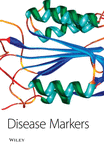Genetic Association and Gene-gene interaction of HAS2, HABP1 and HYAL3 Implicate Hyaluronan Metabolic Genes in Glaucomatous Neurodegeneration
Abstract
Hyaluronan (HA) plays a significant role in maintaining aqueous humor outflow in trabecular meshwork, the primary ocular tissue involved in glaucoma. We examined potential association of the single nucleotide polymorphisms (SNPs) of the HA synthesizing gene – hyaluronan synthase 2 (HAS2), hyaluronan binding protein 1 (HABP1) and HA catabolic gene hyaluronidase 3 (HYAL3) in the primary open angle glaucoma (POAG) patients in the Indian population. Thirteen tagged SNPs (6 for HAS2, 3 for HABP1 and 4 for HYAL3) were genotyped in 116 high tension (HTG), 321 non-high tension glaucoma (NHTG) samples and 96 unrelated, age-matched, glaucoma-negative, control samples. Allelic and genotypic association were analyzed by PLINK v1.04; haplotypes were identified using PHASE v2.1 and gene-gene interaction was analyzed using multifactor dimensionality reduction (MDR) v2.0. An allelic association (rs6651224; p = 0.03; OR: 0.49; 95% CI: 0.25–0.94) was observed at the second intron (C>G) of HAS2 both for NHTG and HTG. rs1057308 revealed a genotypic association (p = 0.03) at the 5’ UTR of HAS2 with only HTG. TCT haplotype (rs1805429 – rs2472614 – rs8072363) in HABP1 and TTAG and TTGA (rs2285044 – rs3774753 – rs1310073 – rs1076872) in HYAL3 were found to be significantly high (p < 0.05) both for HTG and NHTG compared to controls. Gene-gene interaction revealed HABP1 predominantly interacts with HAS2 in HTG while it associates with both HYAL3 and HAS2 in NHTG. This is the first genetic evidence, albeit from a smaller study, that the natural polymorphisms in the genes involved in hyaluronan metabolism are potentially involved in glaucomatous neurodegeneration.




